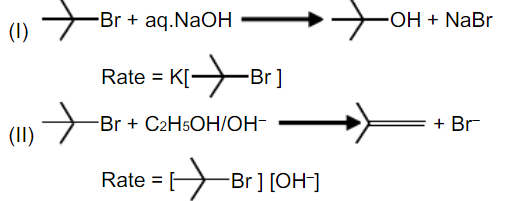A' reacts by following two parallel reactions to give B& C If half of 'A' goes into reaction I and other half goes to reaction-II . Then , select the correct statement(s)
A+NI−−→B+L
A+NII−−→12B+12(C)+L
B will be always greater than C
If 2 mole of C are formed then total 2 mole of B are also formed
If 2 mole of C are formed then total 4 mole of B are also formed
If 2 mole of C are formed then total 6 mole of B are also formed
The correct Answer is:A, D
To solve the problem, we need to analyze the two parallel reactions involving the substance A. Let's break down the steps systematically.
Step 1: Write the Reactions
We have two reactions:
1. Reaction I: A+N→B+L
2. Reaction II: A+N→12B+12C+L
Step 2: Define the Amount of A
Let’s assume we start with x moles of A. According to the problem, half of A goes into each reaction:
- Amount of A in Reaction I: x2
- Amount of A in Reaction II: x2
Step 3: Determine the Products from Each Reaction
Now, we will calculate the amount of B and C produced from each reaction:
- From Reaction I:
- Since x2 moles of A react, the amount of B produced will be x2 moles (assuming a 1:1 stoichiometry).
- From Reaction II:
- Since x2 moles of A react, the amount of B produced will be 14x moles (because only half of B is produced).
- The amount of C produced will be 14x moles (because only half of C is produced).
Step 4: Total Moles of B and C
Now, we can calculate the total moles of B and C produced:
- Total moles of B:
Btotal=BI+BII=x2+14x=24x+14x=34x
- Total moles of C:
Ctotal=CII=14x
Step 5: Compare the Amounts of B and C
Now we can compare the total moles of B and C:
- Since 34x>14x, it is clear that the total moles of B are always greater than the total moles of C.
Step 6: Analyze the Given Statements
1. Statement 1: B is always greater than C. This is correct.
2. Statement 2: If 2 moles of C are formed, then total moles of B are...
- If C=2 moles, then:
14x=2⟹x=8
- Therefore, total moles of B:
Btotal=34x=34×8=6 moles
- This statement is also correct.
Conclusion
The correct statements are:
- B is always greater than C.
- If 2 moles of C are formed, then total moles of B are 6.
We have two reactions:
1. Reaction I: A+N→B+L
2. Reaction II: A+N→12B+12C+L
Let’s assume we start with x moles of A. According to the problem, half of A goes into each reaction:
- Amount of A in Reaction I: x2
- Amount of A in Reaction II: x2
Now, we will calculate the amount of B and C produced from each reaction:
- From Reaction I:
- Since x2 moles of A react, the amount of B produced will be x2 moles (assuming a 1:1 stoichiometry).
- From Reaction II:
- Since x2 moles of A react, the amount of B produced will be 14x moles (because only half of B is produced).
- The amount of C produced will be 14x moles (because only half of C is produced).
Now, we can calculate the total moles of B and C produced:
- Total moles of B:
Btotal=BI+BII=x2+14x=24x+14x=34x
- Total moles of C:
Ctotal=CII=14x
Now we can compare the total moles of B and C:
- Since 34x>14x, it is clear that the total moles of B are always greater than the total moles of C.
1. Statement 1: B is always greater than C. This is correct.
2. Statement 2: If 2 moles of C are formed, then total moles of B are...
- If C=2 moles, then:
14x=2⟹x=8
- Therefore, total moles of B:
Btotal=34x=34×8=6 moles
- This statement is also correct.
The correct statements are:
- B is always greater than C.
- If 2 moles of C are formed, then total moles of B are 6.
Topper's Solved these Questions
- MOLE CONCEPTBOOK - ALLENCHAPTER - MOLE CONCEPTEXERCISE - O-II (Match the column:)
3 Videos
- MOLE CONCEPTBOOK - ALLENCHAPTER - MOLE CONCEPTEXERCISE - J-MAINS
16 Videos
- MOLE CONCEPTBOOK - ALLENCHAPTER - MOLE CONCEPTEXERCISE - O-II (Assertion Reason:)
2 Videos
- METALLURGYBOOK - ALLENCHAPTER - METALLURGYEXERCISE - EXERCISE-05 [B]
26 Videos
- p-Block Element BOOK - ALLENCHAPTER - p-Block Element EXERCISE - All Questions
20 Videos
Similar Questions
Knowledge Check
Product C in the reaction
C2H5BrNaOH−−−−−→(aqueous)ANa−−→BCH3I−−→C will beAPropaneBEthyl iodideCEthaneDEthyl methyl etherIn a reaction,
ANH3−−→Bheat−−→CP2O5−−→C2H5CN
(A), (B) and (C) are :ACH3COOH,CH3COONH4andCH3CONH2BCH3COCI,CH3CONH2andCH3COONH4CC2H5COOH,C2H5COONH4andC2H5CONH2DC2H5CONH4,C2H5CONH2andC2H3COOH
The compounds A, B and C in the reaction sequence
Adiastase−−−−→Bmaltase−−−→Czymase−−−→C2H5OH+CO2 are :
View SolutionDefine the following terms :
(i) Pseudo first order reactions
(ii) Half life period of reaction (t1/2).
View SolutionGive the structures of A, B and C in the following reactions:
C6H5NO2Fe/HCl−−−−→AHNO2−−−→273KBC6H5OH−−−−→C.
View SolutionGive the structures of A, B and C in the following reactions:
C6H5NO2Fe/HCl−−−−→AHNO2−−−→273KBC6H5OH−−−−→C.
View SolutionFor a reaction schemeAk1−−→Bk2−−→C , if the rate of formation of B is set to be zero then the concentration of B is given by :
View SolutionFrom the following mechanism of a complex reaction, find out the order of a reaction, molecularity and rate law :
A+B→M
M+B→N+L(Slow)
N+L+B→C
A+3B→C
View Solution

